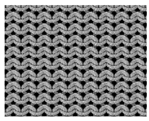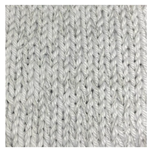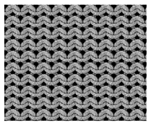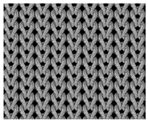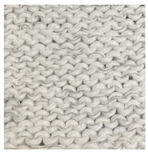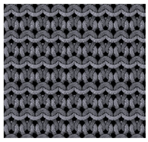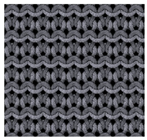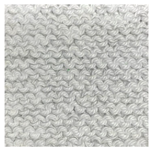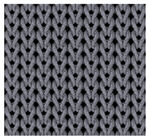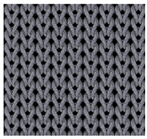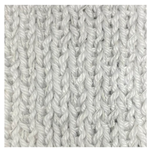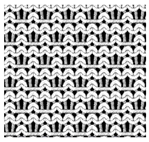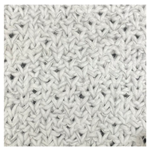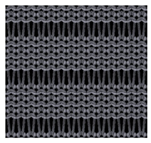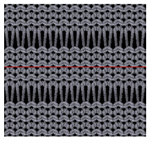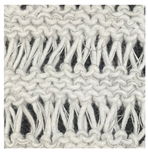Abstract
This study introduces an experimental method for evaluating the reflectivity of flexible textile materials under controlled lighting conditions. The proposed methodology employs a light booth and four standard illuminants (D65, TL84, Incandescent light A, and Department store light CWF), as well as a fixed-position lux meter to assess the reflective properties of textile samples with different knitted macrostructures. Each sample is measured against a black background, and reflectance is quantified as a ratio between the light intensity measured with and without the sample in place. The approach is especially relevant for the textile industry, as it provides valuable insights into the development of sustainable reflective materials for protective clothing and wearable technologies. By offering a repeatable, low-cost measurement technique, this method advances textile metrology, contributing to the optimization of material selection based on reflectivity needs and ensuring reliability across different lighting environments. This research supports the creation of more efficient, sustainable, and adaptive textiles.
1. Introduction
Reflective textile products are widely used in industries such as road safety, sportswear, and specialized uniforms [1]. Measuring their reflectivity is essential for determining their effectiveness under various lighting conditions [2,3].
Traditional reflective threads are typically made from rigid polymer or metallized materials [4] and are primarily used in woven macrostructures, as the weaving process facilitates their integration into the fabric [5]. As a result, woven reflective textiles have limitations like low flexibility, limited comfort, and reduced drapeability [6,7]. These limitations create the need for alternative structures that combine high reflectivity with improved flexibility and comfort. Fabrics with a knitted macrostructure offer precisely this possibility.
There are several methods for evaluating the reflective properties of flexible textile products.
Spectrophotometric analysis of light reflected from a textile macrostructure is a method used to determine the color characteristics and optical properties of textile materials [8]. This method allows for measuring the amount of light reflected from the textile surface at different wavelengths.
A key aspect of spectrophotometric analysis is to measure spectral reflectance, determining what percentage of the incident light is reflected by the textile in the visible spectrum (400–700 nm) [9,10]. This is crucial for assessing the perceived color and brightness of the material. Based on this, color parameters are also evaluated by calculating coordinates in different color spaces (e.g., CIELAB), allowing for an objective assessment of color [11,12]. In practice, spectrophotometry enables comparisons (e.g., of production batches) with reference samples, ensuring consistency in the color and appearance of the textile product [13].
The advantages of the spectrophotometric analysis include high accuracy and repeatability, making it widely used [14]. It provides objective and quantitative data on the optical properties of the textile macrostructure [15]. Additionally, the method is non-destructive, which is important for preserving the integrity of valuable or delicate fabrics. The disadvantages of the method are related to the high cost of spectrophotometers, as well as the expense of replacing reference standards [13], which makes the method inaccessible for manufacturers or laboratories with limited budgets. The spectrophotometer requires regular calibration and a controlled environment to ensure accurate measurements [15,16], as well as specialized training for operation.
Goniophotometry is a method for measuring the reflective and light distribution characteristics of materials, including textiles with reflective properties [17]. Unlike traditional photometric techniques that measure the total reflected light, a goniophotometer records the intensity of light at different angles [18]. In addition to a light source that illuminates the sample at a controlled angle and a sensor for measuring the intensity of the reflected or scattered light, the system is also equipped with a rotational mechanism to rotate either the sample or the sensor to measure reflection at different angles [19]. It is particularly useful for studying retroreflective and reflective materials, such as textiles with reflective threads, road signs, and lighting fixtures [18,20]. However, its use requires expensive equipment and specialized expertise for setup and data analysis, making it impractical for small laboratories.
The Photometric method, using a lux meter, is a simple and accessible way to measure the reflective properties of textile materials. This method is based on measuring the intensity of reflected light using a device (lux meter) that records illumination in lux (lx) [21]. The intensity of the reflected light from a sample containing reflective threads is compared to a control sample (a textile without reflective threads) to determine the efficiency of the reflective material [22]. However, this can be a limitation of the method, as a control sample with the same macrostructure, composition, and characteristics as the specimen containing reflective threads is not always available. The accuracy of the method depends on the measurement angle and ambient light conditions, and, in all cases, it is inferior to methods using a spectrophotometer or goniophotometer [19,23]. Nevertheless, the method has the important advantage of being efficient and quick for use in both laboratory and industrial settings. The equipment is affordable and easy to operate.
Standardized tests are part of international standards that define methods for measuring the reflective properties of textiles. They ensure comparable and accurate measurements by establishing methodologies for evaluating reflectivity. Tests conducted according to specific standards are critical for quality control in the production of protective clothing, sports equipment, and other materials with reflective properties [24].
The main international standards in this field are the following:
- ISO 20471:2013—Defines the requirements for high-visibility clothing used in work and road safety [25].
- ASTM E808/E809—Describes methods for measuring the retroreflection of materials using a goniophotometer [26].
- EN 471—European standard for high-visibility protective clothing, including tests for reflectivity [27]. EN 471:2003 has been superseded by ISO 20471:2013 [25], but it is good to be known for historical comparisons.
The primary testing methods in standardized tests include goniophotometric analysis and spectrophotometry. Additional tests assess the durability of reflective textiles after washing [28], abrasion [29], and exposure to environmental conditions [30]. Standardized tests are essential for ensuring the reliability and effectiveness of reflective textile materials in real-world applications.
Measuring the reflectivity of textiles using spectrophotometry and goniophotometric analysis is expensive and challenging for small laboratories, as well as for small and medium-sized companies aiming to produce fabrics, clothing, or wearable devices with reflective properties [31]. Standardized tests are also primarily based on the use of spectrophotometers and goniophotometers. The most accessible method is the use of a lux meter [32], but it has one major drawback—the reference sample. It is possible that the analysis of a textile product’s reflectivity (fabric) may need to be conducted in the absence of a reference sample with the same macrostructure and characteristics but without reflective elements (threads, fibers, nanoparticles).
This study introduces a method for objectively measuring the reflectivity of flexible textiles using a controlled lighting environment. The methodology employs a light booth with multiple illuminants and a lux meter to assess the reflective properties of knitted textile samples. The proposed approach provides both qualitative and quantitative evaluation of reflectivity, allowing for a systematic comparison of different knitted macrostructures. By considering the influence of fabric design (knitted pattern) on reflectivity, this study supports the development of sustainable, high-performance reflective textiles for protective and wearable applications.
2. Materials and Methods
2.1. Materials
Knit samples made of 100% cotton yarn, doubled with a reflective thread, are used. The cotton yarn has a linear density of 400 tex, while the reflective thread is 175 × 2 dtex with a composition of 75% polyester/25% polyamide (Reflect 500, Madeira Garnfabrik Rudolf Schmidt KG, Freiburg, Germany). The two threads are doubled without twisting before being knitted. A total of 6 samples with different knitting patterns and surface macrostructures are designed, as shown in Table 1. The design simulation is made using Karl Mayer Stoll’s M1+ V7.5 software package.

Table 1.
Design and properties of the knit samples.
The samples were produced using a Silver Reed SK 840 knitting machine. Table 1 shows pictures of the samples and their structural characteristics.
2.2. Methods
Fundamental to the analysis of illuminance and reflectivity of textile samples are three key laws.
The Inverse Square Law provides general information on the distribution of light [33]. It describes how the intensity of light decreases as the distance from the light source increases and is formulated as follows:
where E is illuminance (lx); I is the light source intensity (cd); and d is the distance from the source (m).
In this study, the distance between the light source and the samples is fixed, eliminating the need for measurement corrections. However, the law remains important for interpreting differences in illuminance across different light sources.
The Reflectance Ratio directly characterizes the properties of the tested materials. It is defined as the ratio between the reflected illuminance and the incident illuminance [34], expressed as follows:
where R is the reflectance coefficient (dimensionless quantity); Em is the measured illuminance with the sample (lx); and E0 is the measured illuminance without the sample (lx).
In this study, the reflectance ratio is used to assess the impact of reflective threads on the reflectivity of textile samples. Higher values of R indicate increased light reflection, while lower values suggest a higher degree of light absorption by the material.
Lambert’s Cosine Law describes the dependence of illuminance on the angle of incidence of light on a given surface [35]. It is defined as follows:
where Eθ is the illuminance on an inclined surface (lx); E0 is the illuminance under perpendicular lighting (lx); and θ is the angle of incidence of light.
Equation (3) is relevant when the measured samples are not illuminated perpendicularly. If the light sources are positioned at different angles relative to the samples, this may affect the measured illuminance. In this case, Lambert’s Cosine Law provides the necessary theoretical foundation for interpreting the experimental results.
The required equipment for performing the described in this study reflectivity measurements with controlled light sources includes the following:
- Luxmeter;
- Light Booth with controlled light sources;
- Black pad background to reduce ambient reflections;
- Stand or fixed position for the luxmeter;
- Textile sample with reflective properties.
For conducting the experiment, a controlled lighting environment is used, namely the Light Booth (from BYK-Gardner GmbH, Geretsried, Germany) with different controlled illuminants (Figure 1). Four of them are used in the measurements, namely: daylight D65 (Class B); Incandescent light A, Department store light CWF, and Department store light TL84.
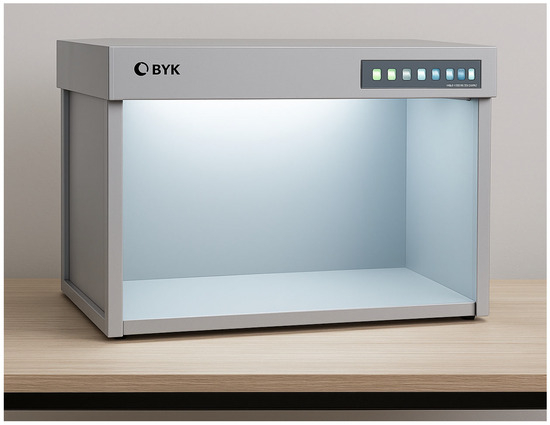
Figure 1.
The used light booth with controlled lightening.
The intensity of the reflected light is measured with a digital LED luxmeter P5086 (from PeakTech Prüf- und Messtechnik GmbH, Ahrensburg, Germany)—Figure 2. The distance between the light source and the sample remains constant. The distance when measuring with the luxmeter is also constant, as the device is placed on a stand. The light beams fall perpendicular to the reflective surface. The luxmeter is also positioned perpendicular to the plane of the surface being measured.

Figure 2.
The used digital luxmeter.
Figure 3 illustrates the steps of the proposed method.
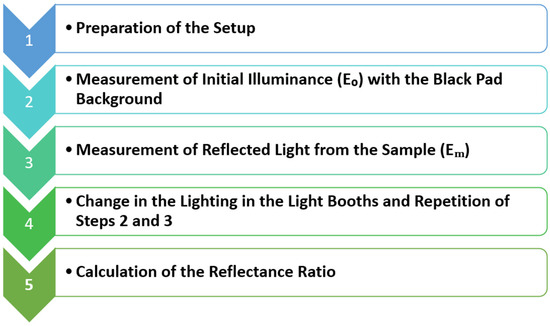
Figure 3.
Sequential steps of the proposed measurement method.
The preparation of the setup (Step 1) starts with the preparation of the light source and materials for measurement. The light booth is opened from the front, and there is ambient lighting in the room, which must be compensated for by background measurement. The lights in the light booths are changed sequentially during the experiment, ensuring the apparatus is fully illuminated with the appropriate light source. A black matte (non-glossy) pad is placed in the test area to eliminate unwanted reflections. The luxmeter is fixed on a stand and remains stationary during all measurements—Figure 4.
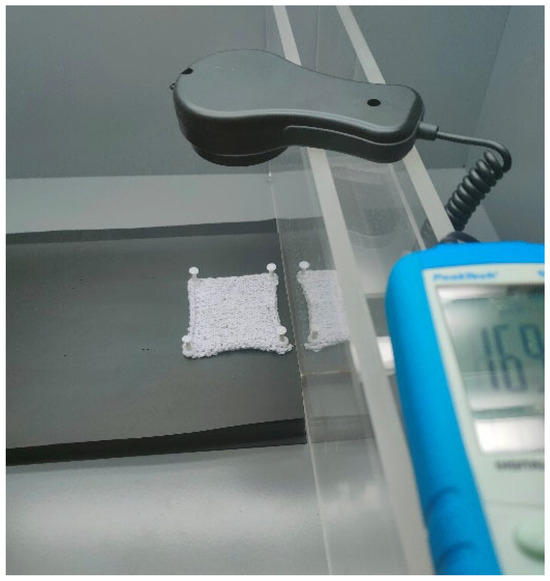
Figure 4.
Preparation of the measurements.
The second step (Figure 3) is the measurement of the Initial Illuminance (E0). The black pad is placed in the measurement zone of the camera without moving the luxmeter stand. The illuminance of the black background is measured using the fixed luxmeter; thus, the value of E0 is recorded. This value represents the baseline illuminance caused by the ambient light and the lights in the camera, without any contribution from the reflective sample.
The third step (Figure 3) is the measurement of the reflected light from the Sample (Eₘ). The test sample is placed on the black pad and fixed, if necessary (Figure 4). The luxmeter remains fixed in the same position as during the measurement of the Initial Illuminance (E0). The illuminance of the reflected light from the sample is measured and recorded as Eₘ.
The change in the lighting in the light booth and repetition of the measurements as a fourth step (Figure 3) can simulate various real-world lighting conditions. Different light sources mimic natural and artificial conditions; therefore, the following lightings are used [36]:
- Daylight D65 (Class B)—a standard light source simulating natural daylight with a color temperature of approximately 6500 K, used in colorimetry for visual assessment of materials.
- Incandescent light A—traditional incandescent lighting with a warm yellow-orange spectrum (~2856 K), commonly used for testing in home environments or streetlights.
- Department store light CWF—cool white fluorescent light (~4150 K), widely used in stores and offices.
- Department store light TL84—neutral “warm” fluorescent light (~4000 K), commonly found in European commercial establishments.
Measuring with different light sources ensures that the tested textile will be effective under any lighting conditions. By changing the light, the metamerism of the product, i.e., the change in color under different lights, can be assessed [37]. This is particularly important for evaluating textiles with a reflective effect because reflective coatings or threads can show how the material will appear in different environments—in daylight, under street lighting, in tunnels, or under car headlights [38].
Different light sources make the angles of refraction and scattering of light on the material change. This is important for assessing retroreflective threads, for example, as they may be highly effective under one light but nearly invisible under another [38]. Checking the reflective properties is also crucial since some textile structures can enhance reflection at specific wavelengths [39].
Last but not least, textiles with reflective elements may lose their effectiveness after prolonged use [3]. Therefore, testing with different light sources helps assess the durability of the reflection and whether the material retains its properties under various conditions.
The last step (Figure 3) includes the calculation of the reflectance ratio, following Equation (2).
2.3. Statistical Analysis
Statistical processing of the data was performed using the Data Analysis ToolPak of Microsoft Excel (Office 365). Three independent measurements were taken for each sample and the respective lighting condition. The reflectance ratio (RR) was calculated according to Equation (2), and the coefficient of variation (CV%) was used to assess the measurement repeatability. Where applicable, error bars representing ± standard deviation have been added to figures to reflect measurement uncertainty.
Linear regression analysis was applied to identify correlations between reflectance values under different lighting conditions. For each regression, the regression line, equation, Pearson correlation coefficient (r), and a 95% confidence interval (CI) were calculated and visualized to estimate the uncertainty.
A k-means cluster analysis was also performed using Excel’s built-in k-means clustering. Prior to clustering, all reflectance values were normalized using min–max scaling. The samples were grouped based on their reflectivity under three lighting types (daylight, fluorescent store light, and regular store light), and the results were visualized as a 3D scatterplot with color-coded clusters.
3. Results and Discussion
3.1. Reflectance Ratio
Figure 5 shows the reflectance ratio of the six knitted samples under four different types of lighting conditions: store light (Department store light TL84), daylight (D65 (Class B)), home light (Incandescent light A), and store light fluorescent (Department store light CWF). The results for the average value and variation coefficient (CV, %) are shown in brackets hereinafter. As explained in Section 2.3, the coefficient of variation (CV%) was selected as a measure of repeatability due to its relevance in textile experimental research.
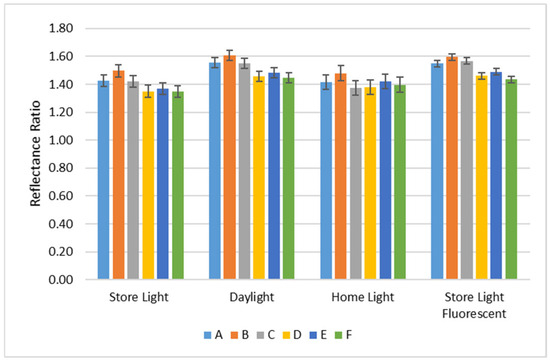
Figure 5.
Reflective ratio of the six textile samples with different knitting patterns under four lighting conditions. The letters A to F represent coded textile samples as defined in Table 1.
The analysis based on the type of lighting conditions shows that the reflectance values range from 1.35 to 1.65, with higher values indicating better reflectivity.
Under store light, the highest reflectance is observed in sample B (1.50, 2.99%) and sample C (1.42, 3.00%), while the lowest is found in sample F (1.35, 3.16%) and sample E (1.37, 3.11%). The difference between the best and weakest sample is 0.15, indicating a moderate effect of the knitting pattern on the reflectance.
Under store light fluorescent, once again, samples B (1.60, 1.47%) and C (1.57, 1.49%) have the highest reflectance. The lowest reflectance is again observed in sample F (1.43, 1.63) and also in sample D (1.46). The difference is about 0.17, which shows a noticeable effect of the knitting structure on the reflective properties.
Under daylight, the best reflecting sample is B (1.61, 2.25%), followed by C (1.55, 2.33%) and A (1.55, 2.33%). The weakest light-reflecting samples are F (1.45, 2.5%) and E (1.48, 2.44%). The difference of 0.16 shows that some textile knits perform better under natural light.
When illuminated with warm light, typical for home lighting, the highest reflectance is found in samples B (1.48, 3.54%) and A (1.41, 3.71%), while the lowest is in C (1.38, 3.81%), D (1.38, 3.8%), and F (1.40, 3.75%). The reflectance is generally lower compared to other lighting conditions.
The analysis of Figure 5 shows that sample B demonstrates the highest reflectivity under all lighting conditions, indicating that its knit pattern is the best for the reflective effect.
Samples A and C also show high reflectance, but with some variations in different lighting conditions. Sample F exhibits the weakest reflectance in all tests, suggesting that its structure absorbs more light or contains fewer reflective threads. The fact is that the modified purl knit (Table 1) creates very large pores and fewer interlacings, which explains the lower reflective capacity of sample F.
Fluorescent lighting and daylight provide the greatest increase in reflectance, meaning that the reflective threads perform better under these conditions.
The coefficients of variation (CV%) indicate good to moderate repeatability of the measurements. The lowest values are observed under daylight illumination (2.25–2.50%), suggesting stable performance in natural light. The highest CV% values appear under home light (3.54–3.81%), indicating greater variability. However, all values remain below 5%, which is an acceptable range for experimental textile studies. Sample A exhibits the lowest overall CV profile, while sample F shows the highest. This highlights again that the choice of lighting conditions affects the consistency of reflectance measurements.
The bar chart in Figure 6 shows the average reflectance ratio (RRav) of each sample under the four lighting conditions. The analysis of the results indicates that sample B (1.54) has the highest mean reflectivity. Therefore, its knit pattern is the most effective for light reflection. Samples A (1.49) and C (1.48) also show high reflectivity but are slightly lower than sample B. Samples D, E, and F have lower RRav, indicating that their structure is less effective at reflecting light.
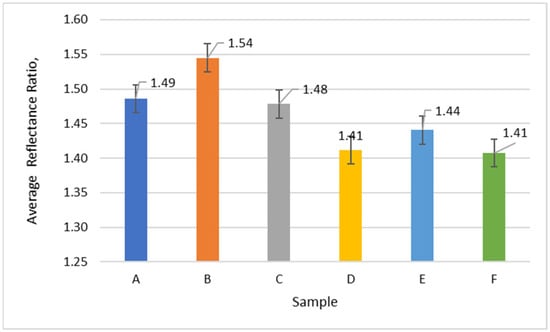
Figure 6.
The average reflectivity of each sample under the four lighting conditions. The letters A to F represent coded textile samples as defined in Table 1.
For additional statistical analysis of the results for the reflectivity of the knitted macrostructures, the coefficient of variation (CV) of the reflective ratio was also calculated as it indicates how stable the reflectivity of each textile sample is under different lighting conditions. The results are summarized in Figure 7.
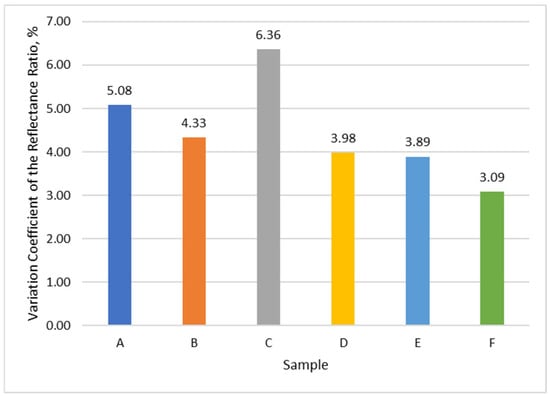
Figure 7.
Coefficient of variation (CV) of the reflective ratio of the textile samples. The letters A to F represent coded textile samples as defined in Table 1.
The analysis shows that sample C has the highest CV (6.36%), meaning its reflectivity varies the most depending on the lighting conditions. This makes it the least reliable of the six fabric designs for environments with different lighting.
The lowest CV (3.09%) is found in sample F, which means its reflectivity varies the least depending on the lighting. However, sample F has the weakest reflectivity of all the samples (Figure 6), and this does not make it the best choice.
Samples B, D, and E have moderate variation (between 3.8% and 4.3%), indicating that they are relatively stable but can be influenced by specific conditions. Sample A has a CV of 5.08%, placing it in the middle range—it is not as variable as C, but not as stable as F. Therefore, for applications that require moderate predictability of reflection, samples B and D could be a good compromise.
The correlation between CV and the average reflectance ratio (RRav) is shown in Figure 8. The red line represents the regression relationship between the average reflectance and the coefficient of variation. The derived regression equation is as follows:
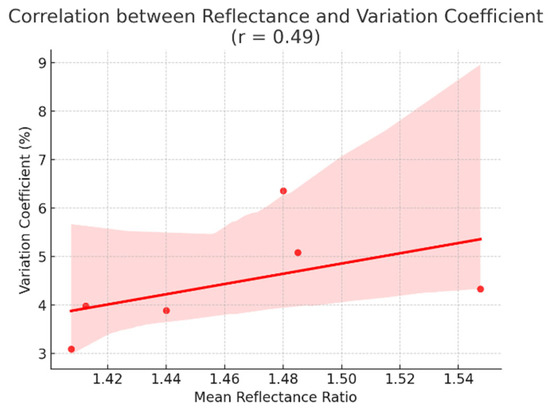
Figure 8.
Correlation between the mean reflectance ratio (RRav) and its coefficient of variation (CV). Red dots indicate individual sample values; the red line shows the linear trend, and the shaded area represents the 95% confidence interval.
The red area marks the confidence interval. It visualizes the degree of uncertainty in the results: a wider area means greater data dispersion.
Most points follow an upward trend, meaning that samples with higher reflectivity are more prone to variate under different lighting conditions. The correlation coefficient (r = 0.49) indicates a moderately strong positive relationship between average reflectance and the coefficient of variation, i.e., not all samples with high reflectivity have high variation.
Figure 9 shows the distribution of reflectance relative to the type of lighting. This view emphasizes the impact of lighting conditions independent of fabric construction. It is clear that the highest mean reflectance ratio occurs under daylight conditions and fluorescent lighting. This means that the investigated textile samples reflect the most light in natural conditions and would perform similarly in commercial and industrial environments.
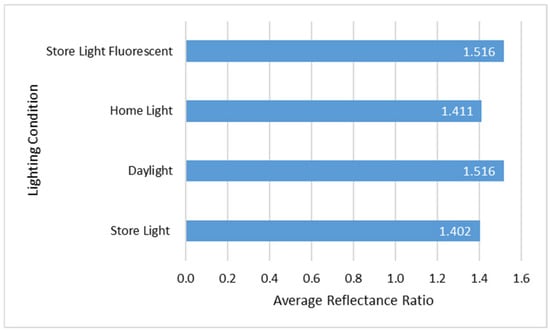
Figure 9.
Average reflectance ratios per lighting condition, calculated across all samples. Intended for general comparison of lighting effects, complementary to Figure 5.
Regular store light gives lower reflectance ratio values than fluorescent lighting due to its warmer spectrum. Confirmation of this is the fact that home lighting, which has the warmest spectrum of the conditions studied, also leads to lower values of the samples’ reflectivity.
Finally, it is clear that regular store lighting and home lighting do not activate the chosen reflective thread used for the knitted samples as effectively.
3.2. Correlation Analysis
An interesting possibility offered by the proposed method is to perform a correlation analysis between the reflectivity of textiles under different types of lighting.
The graph in Figure 10 illustrates the relationship between reflectivity under daylight and fluorescent light for all textile samples. The correlation coefficient is 0.978, indicating a very strong positive relationship. The regression equation is as follows:
where FR is the average value of the reflectance ratio of all samples under fluorescent store light, and DR is the average value of the reflectance ratio of all samples under daylight conditions.
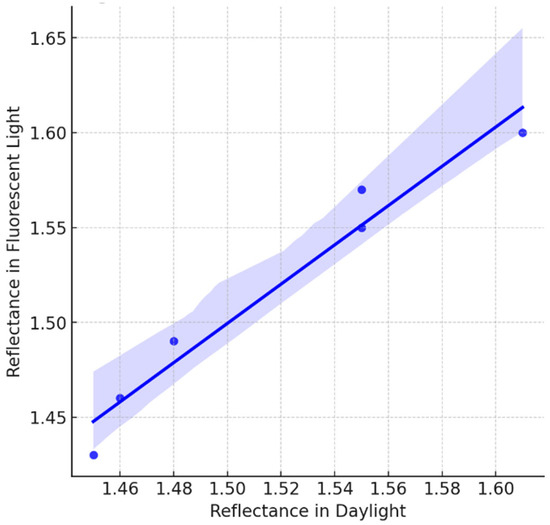
Figure 10.
Correlation between samples’ reflectivity under daylight and fluorescent lighting. Blue dots represent sample values, the blue line shows the regression trend, and the shaded area denotes the 95% confidence interval.
The colored area represents the confidence interval (CI) for the regression line (95%). This result shows that textiles (with the chosen reflective thread) with high reflectivity under daylight almost always reflect well under fluorescent lighting (in stores or industrial spaces). The narrow CI area indicates that the data are strongly correlated.
Figure 11 shows the correlation between reflectivity under daylight and home lighting. Again, the line represents the regression relationship between reflectivity under daylight and home lighting, and the derived equation is as follows:
where HR is the average value of the reflectance ratio of all samples under home light.
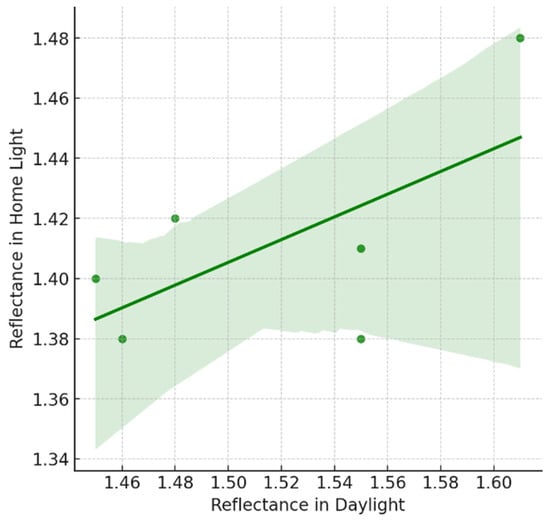
Figure 11.
Correlation between samples’ reflectivity under daylight and home lighting. Green dots represent individual samples; the green line shows the trend, and the shaded area marks the 95% confidence interval.
The correlation between daylight and home lighting is weaker compared to fluorescent lighting. The area in green is the 95% CI. It is wider, indicating that the differences between the samples are greater—some of them reflect very well under daylight but not as effectively under home lighting. Some samples have significantly lower reflectivity under home conditions, meaning that the type of light has a stronger effect on them.
The conclusion is that home lighting has a stronger effect on reducing reflectivity compared to fluorescent lighting. Therefore, for indoor applications, additional tests should be conducted. For stable reflectivity in different environments, textiles that do not lose their properties under warm artificial light should be selected.
It is interesting to make a comparison between the reflectivity of the samples under the two types of store lighting—Figure 12. The purple line represents the regression relationship between reflectivity under regular store lighting (store light) and fluorescent store lighting (store light fluorescent). The derived regression coefficient is as follows:
where SR is the average value of the reflectance ratio of all samples under regular store light.
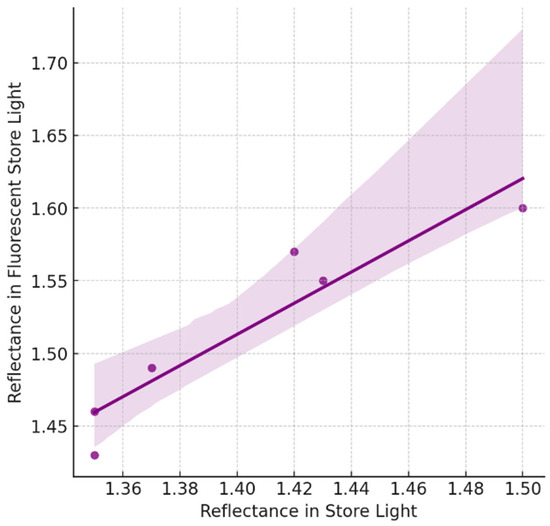
Figure 12.
Correlation between samples’ reflectivity under regular store light and fluorescent store lighting. Purple dots show individual samples; the regression trend is shown by the purple line, with the shaded area marking the 95% confidence interval.
The narrow purple area of the confidence interval around the line indicates a strong correlation, meaning that the reflectivity under both types of store lighting is very similar. The conclusion is that with the chosen reflective thread, if the reflectivity under one type of store lighting is known, the reflectivity under the other light type can be accurately predicted. Fluorescent lighting slightly improves the samples’ reflectance, but not enough to have significant practical implications.
3.3. Cluster Analysis
To demonstrate the proposed measurement method with different types of controlled lighting, we also show the possibility of conducting a cluster analysis. This allows for a deeper understanding of the behavior of the textile samples by grouping them based on their reflectivity under different lighting conditions. Through cluster analysis, samples with similar characteristics are identified, providing valuable information—for example, for the selection and optimization of materials. In the case of this particular study, it is used for the selection of different knitted designs.
The cluster analysis was performed using the k-means method. The textile samples were assigned to a predefined number of groups based on similarities in their reflective properties. Prior to the analysis, the data were normalized to eliminate scale differences between the different measurement conditions. Standard min–max scaling was used, which transforms the values into a range between 0 and 1.
The graph in Figure 13 visualizes the cluster analysis of the textile samples based on their reflectivity under three different lighting conditions: daylight (X axis), fluorescent store light (Y axis), and regular store light (Z axis). The samples are color-coded according to the cluster they belong to, as follows:
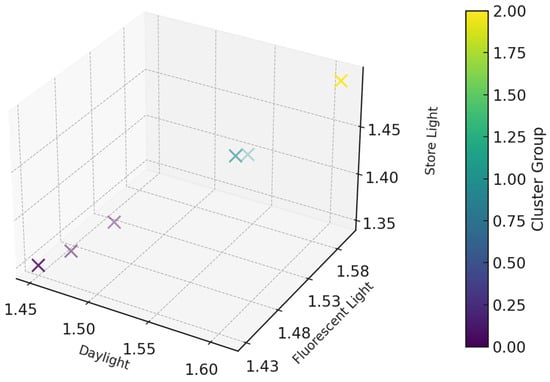
Figure 13.
Correlation between samples’ reflectivity under regular store light and fluorescent store lighting. Colour-coded “X” symbols indicate cluster membership: purple—low, blue—medium, yellow—high reflectivity.
- Purple dots (Cluster 0) represent the samples with low reflectivity under all conditions. These are samples D, E, and F.
- Blue dots (Cluster 1) are samples with medium reflectivity. These include samples A and C.
- The yellow dot (Cluster 2) illustrates the most reflective sample B.
The analysis shows a clear clustering trend, meaning the created knitted designs can be classified based on their reflective properties.
In this sense, the samples in Cluster 0 likely contain fewer or less integrated reflective threads. Cluster 1 contains samples with medium reflectivity, demonstrating moderate effectiveness under different lighting conditions. Cluster 2 includes the sample with the highest reflectivity, which is sample B. This means that its design makes it the most suitable for applications requiring strong reflectivity.
Cluster analysis allows the optimization of selected textiles based on reflectivity needs. In this case, it enables the choice between different designs (knit patterns) that contain the same reflective thread. The cluster analysis shows that reflectivity is not evenly distributed and depends on the design, as some samples maintain consistent properties across different lighting environments, while others exhibit greater variation depending on the type of lighting.
3.4. Summarizing Discussion
The results of the performed study show the effect of lighting conditions on the reflectivity of samples with different knitted macrostructures. The analysis clearly indicates that certain knits perform better under specific types of lighting, with fluorescent lighting and daylight providing the highest reflectivity for most samples. For example, sample B demonstrates the highest reflectivity under all lighting conditions, indicating that its knit pattern is the most effective for light reflection, while sample F has the weakest reflectivity, which may be attributed to its knit structure with larger pores and fewer interlacings.
The correlation analysis conducted across different lighting conditions also supports these observations. The graph in Figure 10 shows a strong positive correlation between reflectivity under daylight and fluorescent lighting (r = 0.978), which means that textiles with high reflectivity under daylight almost always exhibit high reflectivity under fluorescent lighting. These results emphasize that if we know the reflectivity under one of these lighting conditions, we can predict the reflectivity under the other with high accuracy. This is particularly useful for industrial and commercial applications, where lighting conditions typically include fluorescent lamps or daylight.
Interestingly, the analysis shows a weaker correlation between reflectivity under daylight and home lighting (Figure 11). The confidence interval is wider, indicating that the differences between samples are greater—some textiles show very good reflectivity under daylight, but not as effectively under home lighting. For instance, sample A has average reflectivity under all conditions, but under home lighting, it does not reach the level of reflectivity it demonstrates under fluorescent or daylight conditions. This underscores that the type of lighting significantly impacts the reflective properties of textiles, and home lighting, with its warmer spectrum, can reduce the effectiveness of reflective threads. This conclusion is important, as some types of street lighting also fall within this warm spectrum.
Using cluster analysis, it was determined that the samples could be grouped into three clusters based on their reflectivity. Samples with low reflectivity (Cluster 0), such as D, E, and F, likely contain fewer visible or less integrated reflective threads on the front side, explaining their lower efficiency. Samples with moderate reflectivity (Cluster 1), such as A and C, demonstrate medium effectiveness, while sample B, with the most pronounced reflectivity, falls into Cluster 2 and is most suitable for applications requiring strong light reflection.
3.5. Measurement Repeatability and Uncertainty
The present study proposes a methodological approach that, to the best of the authors’ knowledge, has not been described in the existing literature. The measurement setup combines several well-known components into a configuration specifically tailored to flexible textiles. This approach includes the following:
- The use of a lux meter inside a photometric chamber with controlled lighting sources;
- Measurements conducted against a fixed black background;
- Calculation of the reflectance ratio relative to the reference black surface.
The application of the approach to deformable knitted structures presents additional challenges due to their open geometry and surface irregularity.
While each element is individually known, their integration into a coherent and repeatable system for characterizing reflective performance in knitted fabrics represents an applied novelty and fills a methodological gap in current textile research.
To evaluate the consistency of the proposed method, each reflectance ratio was calculated based on three independent measurements. The coefficient of variation (CV%) was computed for each combination of sample and lighting condition to indicate relative variability. All CV values remained below 5%, which is considered acceptable for textile research.
Although the setup is not calibrated against an international photometric standard, it provides internally consistent measurements under strictly controlled conditions. Potential sources of uncertainty include minor sample positioning shifts, ambient light leakage (minimized using a black background and partially enclosed lighting chamber), and structural irregularities in the knitted surface. These factors will be addressed in future work by increasing the number of repetitions and validating results against standardized photometric methods.
3.6. Plans for Future Research
Future research regarding the proposed method for evaluating the reflectivity of textile products using controlled light and a luxmeter will focus on expanding the methodology to assess the durability of the materials. The method could be adapted to include tests for the longevity of the reflective properties. The main focus will be on studying the impact of prolonged exposure to lighting or mechanical stresses, including washing, and how the reflective properties change over time. Potential studies may also include tests to simulate the impact of different climatic conditions (temperature, humidity) on the reflectivity of the materials.
4. Conclusions
This study demonstrates the potential of a practical and accessible method for measuring reflectivity in knitted textile structures using controlled light sources and a lux meter. By analyzing reflectance under four lighting conditions and across six fabric designs, the approach enables a detailed comparison of reflective performance in realistic scenarios.
The novelty of this method lies not in the individual components, which are well-known, but in their integration into a consistent and repeatable setup tailored to flexible, knitted textiles—a gap that current standards and laboratory methods do not address. This combination allows for objective, low-cost, and repeatable reflectivity assessment without the need for a reference sample of identical structure, which is often unavailable in real-world textile innovation.
The method is particularly suitable for small laboratories and SMEs, offering a pathway toward more sustainable, high-performance materials for safety, sport, and wearable technology applications. It enables data-driven selection and optimization of textile designs based on their optical performance, not only in idealized conditions but across varied lighting environments. This makes the approach a valuable contribution to sustainable textile metrology and functional design.
Author Contributions
Conceptualization, R.A.A.; methodology, R.A.A. and E.B.; software D.S.; validation, E.B. and D.S.; formal analysis, R.A.A.; investigation, R.A.A., E.B. and D.S.; resources, R.A.A.; data curation, R.A.A., E.B. and D.S.; writing—original draft preparation, R.A.A.; writing—review and editing, E.B. and D.S.; visualization, R.A.A., E.B. and D.S.; supervision, R.A.A.; project administration, R.A.A.; funding acquisition, R.A.A. All authors have read and agreed to the published version of the manuscript.
Funding
This study and its publication are financed by the European Union—NextGenerationEU, through the National Recovery and Resilience Plan of the Republic of Bulgaria, project No. BG-RRP-2.004-0005.
Data Availability Statement
The original contributions presented in this study are included in the article. Further inquiries can be directed to the corresponding author.
Conflicts of Interest
The authors declare no conflicts of interest.
References
- Maity, S.; Singha, K.; Pandit, P. Introduction to functional and technical textiles. In Functional and Technical Textiles; Woodhead Publishing: New Delhi, India, 2023; pp. 1–30. [Google Scholar]
- Sun, Y. Spectral measurement and data processing of textile surface reflection. Res. J. Text. Appar. 2007, 11, 1–30. [Google Scholar] [CrossRef]
- Seidu, R.K.; Sun, L.; Jiang, S. A systematic review on retro-reflective clothing for night-time visibility and safety. J. Text. Inst. 2024, 115, 1138–1150. [Google Scholar] [CrossRef]
- Bettermann, I.; Löcken, H.; Greb, C.; Gries, T.; Oses, A.; Pauw, J.; Datashvili, L. Review and evaluation of warp-knitted patterns for metal-based large deployable reflector surfaces. CEAS Space J. 2023, 15, 477–493. [Google Scholar] [CrossRef]
- Yang, J.; Ikeuchi, K. A rendering method for woven clothes reflections. Comput. Vis. Image Media (CVIM-140) 2003, 88, 33–40. [Google Scholar]
- Seidu, R.K.; Jiang, S. Functional performance of thin Ag, SS, and Ti films on retro-reflective fabrics. J. Text. Inst. 2024, 115, 781–790. [Google Scholar] [CrossRef]
- Seidu, R.K.; Jiang, S. Analysis of performance properties of retro-reflective woven fabrics made with retro-reflective yarns and natural yarns. Text. Res. J. 2024, 94, 533–551. [Google Scholar] [CrossRef]
- Heider, E.C.; Stucki, C.; Hill, T.; Bell-Hunley, C.; Campiglia, A.D.; Harper, J.K. Activity for examining light reflectance, transmittance, and absorbance with textiles and light-emitting diodes. J. Chem. Educ. 2024, 101, 1325–1331. [Google Scholar] [CrossRef]
- Brittain, H.G. UV/Vis reflectance spectroscopy. In Spectroscopy of Pharmaceutical Solids; CRC Press: Boca Raton, FL, USA, 2006; pp. 141–170. [Google Scholar]
- Periyasamy, A.P.; Vikova, M.; Vik, M. A review of photochromism in textiles and its measurement. Text. Prog. 2017, 49, 53–136. [Google Scholar] [CrossRef]
- Hill, B.; Roger, T.; Vorhagen, F.W. Comparative analysis of the quantization of color spaces on the basis of the CIELAB color-difference formula. ACM Trans. Graph. (TOG) 1997, 16, 109–154. [Google Scholar] [CrossRef]
- Gómez-Polo, C.; Muñoz, M.P.; Luengo, M.C.L.; Vicente, P.; Galindo, P.; Casado, A.M.M. Comparison of the CIELab and CIEDE2000 color difference formulas. J. Prosthet. Dent. 2016, 115, 65–70. [Google Scholar] [CrossRef]
- O’Neill, C.; Hawkes, F.R.; Hawkes, D.L.; Lourenço, N.D.; Pinheiro, H.M.; Delée, W. Colour in textile effluents—Sources, measurement, discharge consents and simulation: A review. J. Chem. Technol. Biotechnol. Int. Res. Process Environ. Clean Technol. 1999, 74, 1009–1018. [Google Scholar] [CrossRef]
- Goodpaster, J.V.; Liszewski, E.A. Forensic analysis of dyed textile fibers. Anal. Bioanal. Chem. 2009, 394, 2009–2018. [Google Scholar] [CrossRef] [PubMed]
- Sule, A.D. Computer Colour Analysis: Textile Applications; New Age International: New Delhi, India, 2002. [Google Scholar]
- Workman, J.J. A review of calibration transfer practices and instrument differences in spectroscopy. Appl. Spectrosc. 2018, 72, 340–365. [Google Scholar] [CrossRef] [PubMed]
- Wang, T.; Lee, E.S.; Ward, G.J.; Yu, T. Field validation of data-driven BSDF and peak extraction models for light-scattering fabric shades. Energy Build. 2022, 262, 112002. [Google Scholar] [CrossRef]
- Chen, C.H. Goniophotometer. In Encyclopedia of Color Science and Technology; Springer International Publishing: Cham, Switzerland, 2023; pp. 860–863. [Google Scholar]
- Fiorentin, P.; Scroccaro, A. Analysis of the performance of a goniometer for studying surface reflection. IEEE Trans. Instrum. Meas. 2008, 57, 2522–2527. [Google Scholar] [CrossRef]
- Bergen, T.; Young, R. Fifty years of development of light measurement instrumentation. Light. Res. Technol. 2018, 50, 141–153. [Google Scholar] [CrossRef]
- Barati, B.; Karana, E.; Sekulovski, D.; Pont, S.C. Retail lighting and textiles: Designing a lighting probe set. Light. Res. Technol. 2017, 49, 173–194. [Google Scholar] [CrossRef]
- Workman, J., Jr.; Mark, H. Using Reference Materials, Part II: Photometric Standards; BaySpec, Inc.: San Jose, CA, USA, 2014. [Google Scholar]
- Lopes, B.M.D.C. LED Light Fixtures Efficiency Analysis and Characterization. Master’s Thesis, Coimbra University, Coimbra, Portuguese, 2013. [Google Scholar]
- Oral, O.; Ozdil, N.; Dirgar, E. Investigation of the changes in reflective properties of reflective tapes due to various effects. Ind. Textila 2023, 74, 267–272. [Google Scholar] [CrossRef]
- ISO 20471:2013; High Visibility Clothing—Test Methods and Requirements. International Organization for Standardization: Geneva, Switzerland, 2013. Available online: https://www.iso.org/standard/42832.html (accessed on 7 March 2025).
- ASTM E808-01(2013); Standard Practice for Measuring Photometric Characteristics of Retroreflectors. ASTM International: West Conshohocken, PA, USA, 2013.
- EN 471:2003; High-Visibility Warning Clothing for Professional Use—Test Methods and Requirements. CEN: Brussels, Belgium, 2003. Available online: https://www.en-standard.eu/ (accessed on 7 March 2025).
- Rotzler, S.; Krshiwoblozki, M.V.; Schneider-Ramelow, M. Washability of e-textiles: Current testing practices and the need for standardization. Text. Res. J. 2021, 91, 2401–2417. [Google Scholar] [CrossRef]
- Altaş, S.; Yılmaz, E.; Adman, N. Improving the repetitive washing and abrasion resistance properties of fabrics produced with metallized yarns. J. Ind. Text. 2022, 52, 1528083720942961. [Google Scholar] [CrossRef]
- Synnefa, A.; Santamouris, M.; Livada, I.J.S.E. A study of the thermal performance of reflective coatings for the urban environment. Sol. Energy 2006, 80, 968–981. [Google Scholar] [CrossRef]
- Panda, H. Handbook on Paint Testing Methods; ASIA Pacific Business Press Inc.: New Delhi, India, 2010. [Google Scholar]
- Hu, B.; Li, D.; Ala, O.; Manandhar, P.; Fan, Q.; Kasilingam, D.; Calvert, P.D. Textile-based flexible electroluminescent devices. Adv. Funct. Mater. 2011, 21, 305–311. [Google Scholar] [CrossRef]
- Fei, L.; Zhang, Q.; Deng, Y. Identifying influential nodes in complex networks based on the inverse-square law. Phys. A Stat. Mech. Its Appl. 2018, 512, 1044–1059. [Google Scholar] [CrossRef]
- Tominaga, S.; Wandell, B.A. Standard surface-reflectance model and illuminant estimation. J. Opt. Soc. Am. A 1989, 6, 576–584. [Google Scholar] [CrossRef]
- Wolff, L.B. Generalizing Lambert’s law for smooth surfaces. In Proceedings of the Computer Vision—ECCV’96: 4th European Conference on Computer Vision, Cambridge, UK, 15–18 April 1996; Springer: Berlin/Heidelberg, Germany, 1996; Volume II 4, pp. 40–53. [Google Scholar]
- BYK-Gardner. Operating Manual: Byko-Spectra Standard. Available online: https://www.byk-instruments.com/en/Color-Control/byko-spectra-LightBooth/Cost-effective-light-booths-with-5-Illuminants/c/p-442 (accessed on 12 March 2025).
- Akbarinia, A.; Gegenfurtner, K.R. Color metamerism and the structure of illuminant space. J. Opt. Soc. Am. A 2018, 35, B231–B238. [Google Scholar] [CrossRef]
- Uddin, A.J. Novel technical textile yarns. In Technical Textile Yarns; Woodhead Publishing: Cambridge, UK, 2010; pp. 259–297. [Google Scholar]
- Reinert, G.; Fuso, F.; Hilfiker, R.; Schmidt, E. UV-protecting properties of textile fabrics and their improvement. Text. Chem. Color. 1997, 29, 36. [Google Scholar]
Disclaimer/Publisher’s Note: The statements, opinions and data contained in all publications are solely those of the individual author(s) and contributor(s) and not of MDPI and/or the editor(s). MDPI and/or the editor(s) disclaim responsibility for any injury to people or property resulting from any ideas, methods, instructions or products referred to in the content. |
© 2025 by the authors. Licensee MDPI, Basel, Switzerland. This article is an open access article distributed under the terms and conditions of the Creative Commons Attribution (CC BY) license (https://creativecommons.org/licenses/by/4.0/).

